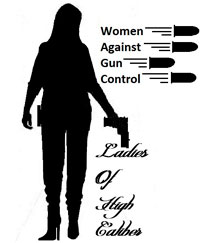ARMED SELF-DEFENSE WHO’S REALLY DECEIVING WOMEN
ARMED SELF-DEFENSE WHO’S REALLY DECEIVING WOMEN
http://www.etherzone.com/2002/renn011002.shtml
ARMED SELF-DEFENSE:
WHO’S REALLY DECEIVING WOMEN?
By: Annie Renner
Our “friends” at the Violence Policy Center recently released their annual
“When Men Murder Women” study. This year they used the study as a means to
accuse the firearms industry and the NRA of perpetuating “the stereotype of
the ‘dangerous stranger’ as the primary threat to a woman.” According to
Karen Brock, a health policy analyst for VPC, scenarios in which a stranger
attacks and mugs a woman in a dark alley or breaks into a woman’s home to
rape and kill are among the least common dangers women will ever face.
Brock goes on to tell us that the gun industry, realizing the traditional
market of white males has been saturated, has focused on women as the next
source to market their wares. In order to sell as many guns as possible to
the untapped female market, firearms manufacturers, pro-gun magazines and
firearms dealers have promoted the “bogus” idea that women are in danger
from strangers.[i] The Violence Policy Center cautions, “Women must
consider the risks of having a gun in their home, whether they are in a
domestic violence situation or not”[ii] and concludes the study by
observing, “For women in America, guns are not used to save lives, but to
take them.”[iii]
According to the study, 60% of female homicide victims were wives or
intimate acquaintances of their killers.[iv] While it is true that crimes of
violence committed by persons known to the victim are more prevalent than
crimes of violence committed by strangers, numbers alone cannot tell the
story when it comes to the murder of women by former intimate partners.
Many questions come to mind. How many of these women were depending on a
restraining order or other court ordered piece of paper to protect them from
violent intimates? In how many cases was the gun actually owned by the
woman or kept at her residence? How many women were unarmed and had no
viable means of defending themselves against an armed attacker? How many
assailants knew they would be all but unopposed in their attack or that a
gun would trump any means of defense their wife, former wife or girlfriend
had on the premises? How many victims would still be alive if they had had
access to a firearm for self-defense?
Those are all legitimate questions that can’t be answered by crime
statistics tables. Still, Brock races forward in full support of the
“study” advising women to shun armed protection. She suggests that they
have little to fear from strangers and, further, that laws (such as the 1996
Domestic Violence Misdemeanor Gun Ban[v]), court orders and police
protection are adequate measures to take in regard to self-protection. In
reality, the VPC and Ms. Brock are actually advising women to take steps
that may further endanger them. Perhaps it would benefit Ms. Brock and her
fellow VPC supporters to meet some of the women who chose to ignore their
“advice.”
Consider the plight of Tammy Renee Thompson of Augusta, Georgia, for
example. In February 2001 Tammy’s ex-boyfriend was arrested for assaulting
and pointing a weapon at her. He was released from jail after posting a
$16,250.00 bond and was awaiting trial when he again tried to attack her in
July 2001. After shattering a window next to her front door, he let himself
into her home and tried to assault her with a piece of concrete. She fired
.38-caliber revolver and struck him dead center in the right eye. “She was
afraid for her life, and she took steps to lessen the threat,” said Sgt.
Wayne Bunton. No charges were filed.[vi]
Leslie Joni Prater of Clarksville, Tennessee found herself in similar
jeopardy, but like Tammy was prepared to defend herself. Leslie was asleep
in her bed when she was awakened by the sounds of her ex-boyfriend breaking
into her home. A struggle ensued as she tried to keep him out of the house
but her strength was no match for his. As he came into the room, Leslie ran
around to the other side of the bed to get a .38-caliber pistol. The
ex-boyfriend lunged across the bed at her and she fired. Her first shot
missed; the second struck him in the stomach. According to investigators,
the man had been stalking Leslie for months and had broken into her home
just three weeks earlier. Police commented that Leslie was lucky to be
alive.[vii]
Consider also the case of Maria Cruz of Las Vegas, Nevada. Maria’s
common-law husband kept her tied up for at least part of the four days she
was held captive in the couple’s home. He tortured her by heating a butter
knife over a gas stove and burning her hands, legs, breasts and vaginal area
with it. She was bruised from numerous beatings (a neighbor described her
face as a “bloody pulp”) and subjected to threats that she would be killed.
Maria managed to convince her husband that she needed to care for her
children – ages 12, 2 and 1 – to prompt him to untie her. She retrieved a
handgun and fired five times, killing her torturer. The husband had a
history of domestic violence and threatened to kill Maria if she ever
reported it to authorities. No charges were filed.[viii]
Would these women be with us today if they had not had access to a gun? No
one can say for sure, but one thing is certain: The guns in their homes were
a far greater threat to the attackers than they were to the women who used
them.
Threats By Strangers
Although domestic violence and murder committed by intimate acquaintances is
a serious concern, it is foolhardy to minimize the very real dangers posed
by strangers. Murders committed by strangers are not as uncommon as the VPC
would like you to believe. For instance, in 14% of all murders committed
between 1976 and 1999, the victim and offender were strangers.[ix] Some
might consider that to be a relatively small percentage but it certainly is
worth noting. Yet to read the VPC report or Ms. Brock’s editorial one would
think that women need not concern themselves with attacks by strangers;
after all, it’s just a “bogus” idea designed to drum up business for the gun
industry.
Murder isn’t the only violent threat with which women must be concerned, but
the VPC and Ms. Brock fail to address other violent crimes. For instance,
in 1999 (the year on which this VPC report is based) strangers were
responsible for 35% of the violent crimes committed against women.[x] Again
using 1999 statistics, 39% of aggravated assaults against females were
perpetrated by an assailant not known to the victim.[xi] Of the 381,400
rapes and sexual assaults in 1999, 34% (or 129,890) were committed by
strangers.[xii] It would seem that the “stereotype” of the “dangerous
stranger” is not a stereotype at all, but a realistic threat that women
should be prepared to handle.
Furthermore, in nearly 90% of violent crimes directed against women, the
offender does not have a gun; and in only 10% of rapes does the rapist carry
a firearm.[xiii] Thus, an armed woman usually has a decided advantage over
her assailant.
Still, whether through ignorance or duplicity in order to advance an
anti-gun agenda, the VPC continues to advise women against having a gun in
the home. One has to wonder whether the Violence Policy Center is as
anti-woman as they are anti-gun, for it seems clear that unarmed female
victims are much preferable to them than are armed survivors.
—————————————————————————-
—-
[i] Brock, Karen. Bogus Gun Pitch Deceives Women, Atlanta Journal and
Constitution, November 8, 2001
[ii] When Men Murder Women: An Analysis of 1999 Homicide Data, Violence
Policy Center, November 2001.
[iii] See Supra note ii
[iv] See Supra note ii
[v] Prohibits anyone who has been convicted of a misdemeanor crime of
domestic violence or child abuse from purchasing or possessing a gun.
[vi] The Augusta Chronicle, Augusta, Georgia, July 31, 2001
[vii] WKRN.com, Nashville, Tennessee, August 21, 2001
[viii] Las Vegas Review-Journal, Las Vegas, Nevada, October 26, 2001
[ix] Homicide Trends in the U. S – Intimate Homicide, U. S. Department of
Justice, Bureau of Justice Statistics, January 4, 2001.
[x] National Crime Victimization Survey, Criminal Victimization in the
United States, 1999 Statistical Tables, U. S. Department of Justice Bureau
of Justice Statistics, Table 29, January 2001
[xi] See Supra note x at Table 43a
[xii] See Supra note x at Table 27
[xiii] Kates, Don B. Jr. Guns, Murders and the Constitution: A Realistic
Assessment of Gun Control (1990), at 29, citing U. S. Bureau of Justice
Statistics, also See Supra note x at Table 66



